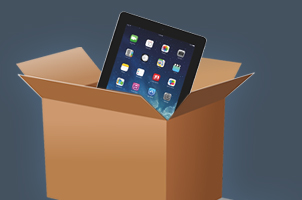The day has finally come and there is a crack running down your iPad screen. When you first notice it, you may try to determine if it is a true crack or just a mark on the iPad. Once it sets in that it is indeed a crack, you may be worried that your device is doomed.
Cracks have a number of stages they go through and each one will usually progress from one stage to the next depending on how long you wait to repair your screen, you may see this progression occur. Below, we will take a look at the different types of cracks.
One Small Crack
This is the smallest crack that you can get on your iPad device, and you may not even notice it when it happens. It will likely be one of those situations where you look at it, notice the crack, and wonder how it got there. The size of the crack is maybe about an inch and often occurs near one of the corners of the device due to a drop or bump.
You will likely find that your iPad functions just fine with this crack in it, but you want to keep a watchful eye on the crack itself because it can start to spread and get worse over time, especially with a subsequent drop or even pressing too hard in that spot. You will definitely want to make sure you have a screen protector on it.
Spreading Cracks
If you start to notice spreading cracks on your iPad screen, this is the first indicator of something bad. You can usually still use the device, but the cracks are very apparent and may be in your way as you use the device. You want to keep a close eye on these cracks as they can easily spread even with the slightest touch.
Side to Side Crack
This is where the real trouble starts to begin for you. This type of crack will usually span from corner to corner on the device or from top to bottom, side to top, etc. When a crack is this big, it is usually pretty deep too and can start to cause issues with the display of the screen.
If you do plan to continue to use your device with a crack like this on it, you must be careful as you can further damage the device. You want to avoid touching the crack or pressing too hard on or near it as it may make the crack worse or affect the screen.
Long Cracks Accompanied By Color Distortion
Here come the issues with useability of the device. These types of cracks will cause the screen around them to become distorted and make it hard to see the information or text on the screen itself. You may notice that the screen jumps around a little bit or there is a rainbow color effect near the crack itself. These types of cracks can spiderweb easily and this is something you do not want to happen. In this stage, your screen is failing.
Multiple Cracks or Shatter
This type of damage can happen from the small crack that once started on your device, or you can accidentally drop the iPad and end up with a device with a shattered screen. A bunch of cracks all across the screen is the worst situation that can happen. Your iPad is extremely vulnerable to dirt, dust, and liquid getting into it, so you want to protect it as best as possible.
The shattered screen may cause glass shards to get into your fingers while you try to use the iPad and you may even find that your device is not able to be used.
Professional iPad Screen Repair in NYC
If you have discovered that your iPad screen is cracked or shattered, you want to get it fixed. A small crack can lead to much more serious problems and eventually expensive repairs. The sooner you get your device fixed, the better. If you are searching for affordable iPad screen repair in NYC, you have come to the right place. We have OEM-quality screens in stock right now and can replace most screens the same day. Book your appointment online with us or give our team a call to schedule a repair.

